#forgotten masterpieces
Explore tagged Tumblr posts
Text
Saimir Kristo: Architecture Is The Means To Create A Common Language Of Living
Weltraum, a radio podcast about space on the jabbering Independent Coastal Radio NOR hosted Saimir Kristo ... I had this great opportunity to talk about the city, his ideals and thoughts.

Saimir Kristo | Photo © Kristiana Meço
How Tirana changed in last 20 years?
Saimir Kristo: Talking about the weather it was much more rainy. It used to be the rainy city in Albania twenty years ago, when I come back from Greece. It changed radically. In 2004 there were not even proper bars. Of course nobody cared about the bars in that time, the country was just going out of a difficult period from the civil war in 1997, where pyramid schemes tricked citizens and took away their money. Fifteen years ago I am not really sure if we were not able to escape from this closed territorial system but today is the other problem, that people are leaving, there are massive emigrations. The problem I face as an individual but also as an architect in the last twenty years working in remote areas of Albania.
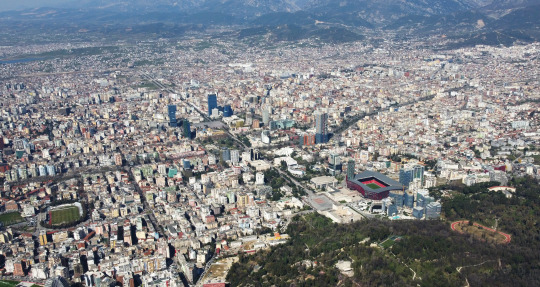
Tirana Aerial View | Photo © Open House Tirana
When I come back there was this amazing energy where people from Albania want to change the country, they wanted to go out from those enclaves from the past. There were many cases of informality in the 1990s, many cases of wild development, but there were people with the amazing energy. Whenever we have problems and we have the energy, we can always solve all problems because we have people around to solve it together. What about if you have depth and you go to the rural areas of Albania? Those villages were very much present in the landscape of the county but today are almost empty. Villages of once 1.000 inhabitants have now only thirteen people.
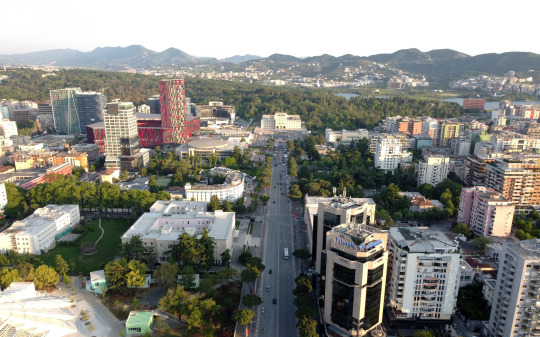
Tirana New Boulevard | Photo © Open House Tirana
The intention to move into big urban centres in the 1990s was very huge, it was a huge mass immigration. Today it's starting again. When I moved to Tirana there was just almost a half of a million people, reaching today a number of one million. So from 2,5 million Albanians that have left the county one million lives between Tirana and Durrës, the main port city. And we have 29.000 km2 of the territory. This is an important way to speak how Albania changed.
It is not always about architecture?
SK: I think is barely about the architecture. Architecture it is the means to justify, to camouflage, to improve and to manifest that people are much more sensitive about it. It is the means to deconstruct mentalities but also a means to educate to improve the settings and create a common language of living, of being. All these years of architecture in Albania, not as innovative approach because if was used in a part, is used in a way to transfer the identity of the city. I have a very famous image in mind, in 1990 when the main Skanderberg square had only pedestrians, only one bus and one truck.

Skanderbeg Square during daytime.| Photo © Open House Tirana
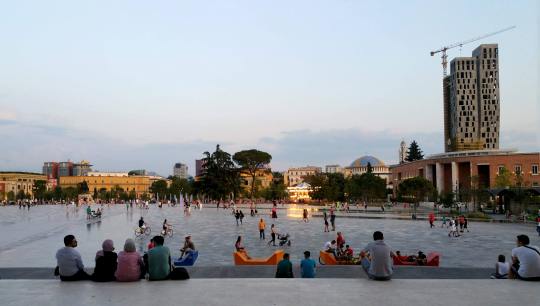
Skanderbeg Square changes it's identity during the evening.| Photo © Open House Tirana
Architecture is the means to justify, to camouflage, to improve and to manifest that people are much more sensitive about it. It is the means to deconstruct mentalities but also a means to educate to improve the settings and create a common language of living, of being.
People were thinking we had a very organised square with the right amount of people (whatever that means), a public transport with one bus. What if we go back to this situation? That can be very dangerous, because the Skanderberg square didn't had cars because people didn't want to use cars but because no one have a car easily. People also didn't feel the square as a public space but a main space for demonstration of the propaganda of the authoritarian regime of Hoxha. In the same way are the public spaces today, they might seem more contemporary organised but they are made only for events, either a political meeting, music concert or sports gather.
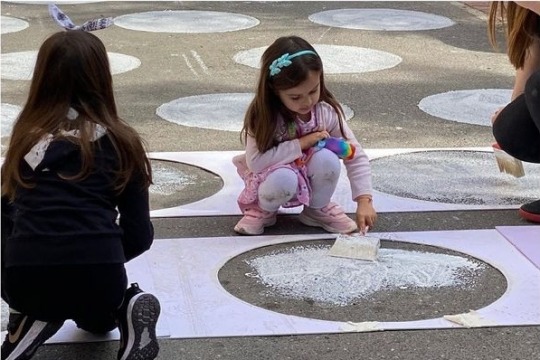
Urban Streetscapes: Filter Caffee Filtre | Photo © Tirana Architecture Triennial
The real life in squares makes them lively after midnight or early morning, where there is no urgency to be there but just a pure pleasure or desire. Architecture was and it still used to express political dominance and authority. To have a beautiful architecture we have to present it and experiment. I don't like the word educate, I think to have this relationship of co-ownership of projects that people really want.
The real life in squares makes them lively after midnight or early morning, where there is no urgency to be there but just a pure pleasure or desire.
As an educator you work in an educational institution, how is educational system about architecture in Albania functioning?
SK: It is situated on a dogma of the repetitive reproduction of something before, which is also linked to today, because students tend to limit their creativity because of the restrict educational system and their project doesn't resemble the project of their professors. This is a problem of us, educators. We have to change that. We continue to teach students what we were thought twenty, thirty years ago. We need to transform radically they way we do it. We shall focus on the importance of reading, going in depth of students ideas and expressions. Then students can find right tools to express better. We always try to copy what is present as innovative. It is on us, professors to educate ourselves more, read more and listen more. This is the the problem of architects, they don't listen so much but tend to speak.
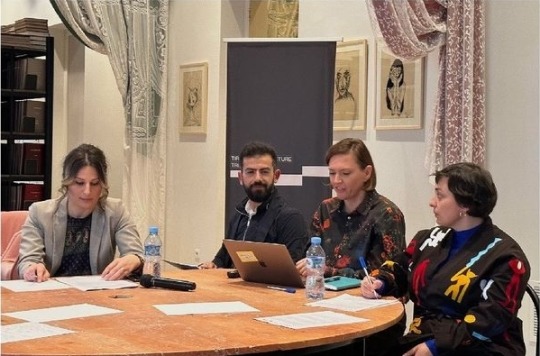
Roundtable Virtual or Physical; from left to right Etleva Dobjani, Saimir Kristo, Dijana Vučinić, Tinatin Gurgenize. | Photo © Tirana Architecture Triennial
The other topic, which I am very critical about, is the issue of non payed work. This has became a standard. We teach students to be aware of how much they need to be payed to be able to value their work. These are things that were never talked before in the auditorium.
Maybe LINA is the good opportunity for that; what did LINA created for Bartleti?
SK: Some of our LINA fellows presented the issue of inclusivity and education, which makes me very proud of. For Bartleti LINA collaboration makes a very important presence for bringing fresh ideas from incredible fellows with a high level of integrity and professionalism. On the other side this enhanced courage to our students to work with these topics and collaborate with the others. It is a case of asking question in a classroom and feeling a prejudice why are you asking this question. If you see other people having the same question, the you are part of the community. The other important issue is a continuous collaboration with other institutions that are part of LINA. I always have called this more that European union of architecture, because it extends beyond Europe.

Space Saloon + The MAAK | Photo © Tirana Architecture Triennial
International collaboration can not only be used as a mean to justify but can also be used as a means to go further, to look beyond and investigate a very delicate problem. Last year we had an opportunity to host New South with the issue of Sacred grounds.

Sacred Grounds by New South. | Photo © Tirana Architecture Triennial
We have this phenomenon of reduced co-existance in Albania. We have four different religions, which all cohabitate together. This is because our dictator abroad the religion in the 1960s, so when there was no religion, they need to find a common language to keep their faith inside them. In the New South's installation in the National historic museum, the most dictatorial building in Albania, presented all these four religion and in such way created a non physical temple for people of all these four religions inside an extra dogmatic building. We try to touch not only the build aspect but also how we perceive the space.
What kind of act is the demolishment of the National Theatre of Albania that happened few years ago?
SK: The demolition of the National Theatre was a collective act. It was not just an act to build a new theatre. It is not only an act by the government to transform a public space, get read of the old building or neglect it' s value. I think it's an act of us as architects, us as citizens of Tirana, not to raise the attention to all other historical buildings that have been left to the mercy of time since thirty years now. It is something we need to reflect in our consciousness. We might not have the money to restore the building, as culture is the smallest portfolio in our government. We have to ask for more. Demolitions is not something sporadic, that happened with the theatre, this is happening with hundred of historical buildings in Tirana and all around Albania. (Saimir presented the Forgotten Masterpieces of Albania in some of our previous talks).
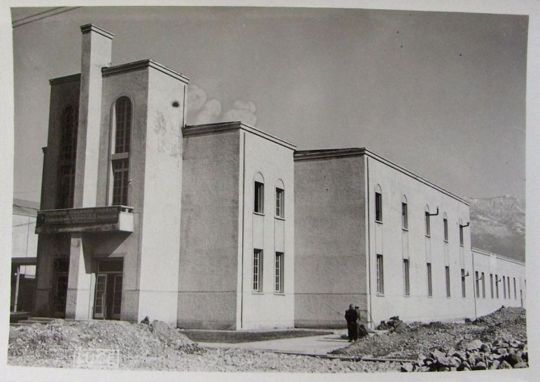
The National Theatre in Tirana. | Photo via Architectuul
We are always there in the last moment, when we know that there is one percent of chance to save it. We should emphasise the importance of thesis buildings and find a way to restore them. The city from twenty years ago it's not recognisable today. This is telling a lot about us, because to rebuild and restore takes a lot more time to discuss and work on that. In many levels the case of theatre is a consume story but it's also an inflation of our society and at the end you have one more building less to admire. The 17th of May 2020 at 4:30 in the morning, that's when the theatre collapsed, should not be the moment to ask the old theatre to be rebuild again in the place of the old one, but should be a moment to commemorate how neglected we were as a society and how important is to turn the attention on the city that we are taking advantage of.

Northern Boulevard Extension | Photo © Open House Tirana
The memory of the city is always important and we need to be able to pass over the memory of the story of the historical theatre to the next generations and not to romanticise the idilic idea of a new theatre by BIG. It is important of how to show the identity of our city.
How do you see architecture in the future?
SK: Beautiful! Why not! I am not part of the dramatic and pessimist discussions that architecture and our cities are getting worse. We have students that are not compromising themselves and they want to do a change. I want to Wellcome all the changes to see myself as a part of this evolving system. With new students working in the field of architecture we just have a bright future. What we need is to embrace all these things to feel them. We have to open our minds and to wake up. We have to keep the dream of our inner small Chile inside and working in architectural education we are responsible to keep that dream of all these young students alive and we have to foster it.
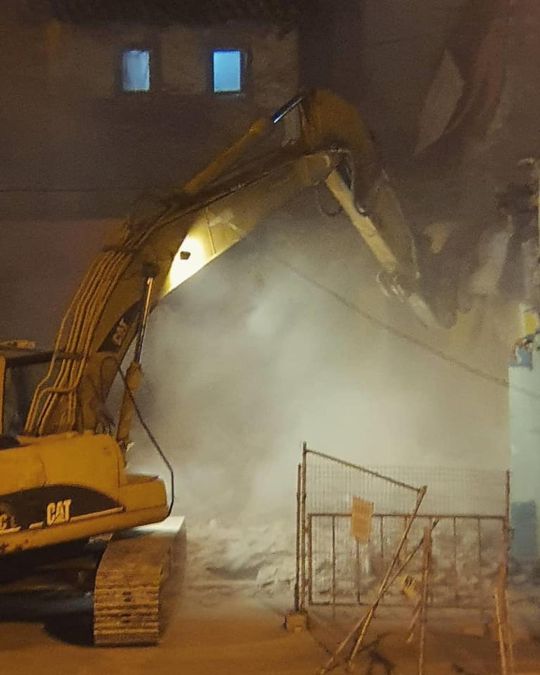
The National Theatre of Albania was demolished on 17. May 2020 at 4am. | Photo © Saimir Kristo
Saimir Kristo, P.hD. is an architect and urban designer, currently Deputy Dean and Lecturer at the Faculty of Applied Sciences and Creative Industries at BARLETI University. Founder of Tirana Architecture Triennale - Architecture Fund in Albania and Open House Tirana. He is an APLS Alumnus invited by the Austrian Ministry of Foreign Affairs and IVLP Alumnus invited by the US State Department representing civil society in Albania. As an active member of civil society, he is engaging communities to develop a common educational platform in the field of architecture and urban planning. His professional practice IXI Architecture is working in tangible and intangible mediums to transform urban design and architecture in Albania for the better. He holds a Ph.D. in Architecture and Urban Planning Focused on city morphology and urban catalysis and their role in the transformation of public spaces, a research result of his experience as a project leader in Urban Regulatory Plans in Albania. His scientific activity extends with monographs and publications but also as a jury member in international competitions. He serves as the Independent Nominator for the “EU Mies van der Rohe Award” appointed by the Fundacio Mies van der Rohe for Albania. Since its establishment, he has been a board member of "Fundjavë Ndryshe" foundation.
Here You can listen to the WELTRAUM interview.
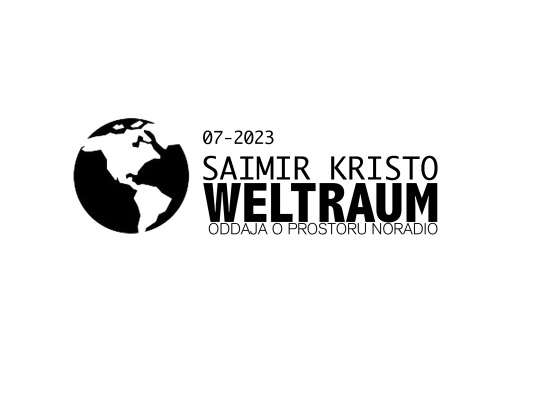
2 notes
·
View notes
Text

#a doodley#had such a horrible time trying to draw tonight how do i draw (faces) nearly every day and i still dont get it.#realized rn that ive forgotten how to draw like tops/backs of heads but i look at art from months ago and see that i never actually knew#i want to be more loose with my stuff but then it comes out looking Bad Bad instead of good bad#i dont get it and it never sticks and im so ashamed.....!#im so ashamed.... there's ppl making masterpieces in between studying to become doctors and im here#with all the free time in the world. from birth to present. and it's never gotten any better. despite any of it#everything i learn just turns to dust in time and idk how i want my art to look and i hate that it looks like me and has too much Me.#that's why it sucks i bet#im going to bed before i tear my hair out over not being able to draw#it's deteriorated so much more over the years bc now i overthink every little detail. how do i let go. AND make it look good.
66 notes
·
View notes
Text

𝐇𝐞𝐲 𝐦𝐲 𝐥𝐨𝐯𝐞𝐬!
𝘐’𝘷𝘦 𝘩𝘢𝘷𝘦 𝘴𝘰𝘮𝘦𝘵𝘩𝘪𝘯𝘨 𝘳𝘦𝘢𝘭𝘭𝘺 𝘪𝘮𝘱𝘰𝘳𝘵𝘢𝘯𝘵 𝘵𝘰 𝘢𝘴𝘬 𝘺𝘰𝘶. 𝘐’𝘮 𝘴𝘵𝘢𝘳𝘵𝘪𝘯𝘨 𝘵𝘰 𝘥𝘰 𝘪𝘯 𝘥𝘦𝘱𝘵𝘩 𝘢𝘯𝘢𝘭𝘺𝘴𝘪𝘴 𝘰𝘯 𝘶𝘯𝘬𝘯𝘰𝘸𝘯 𝘢𝘯𝘥 𝘧𝘰𝘳𝘨𝘰𝘵𝘵𝘦𝘯 𝘮𝘰𝘷𝘪𝘦𝘴 𝘢𝘯𝘥 𝘴𝘩𝘰𝘸𝘴 𝘰𝘯 𝘵𝘩𝘪𝘴 𝘴𝘪𝘵𝘦, 𝘴𝘰 𝘐 𝘯𝘦𝘦𝘥 𝘺𝘰𝘶𝘳 𝘰𝘱𝘪𝘯𝘪𝘰𝘯 𝘰𝘯 𝘸𝘩𝘪𝘤𝘩 𝘱𝘪𝘦𝘤𝘦 𝘰𝘧 𝘮𝘦𝘥𝘪𝘢 𝘐 𝘴𝘩𝘰𝘶𝘭𝘥 𝘧𝘰𝘤𝘶𝘴 𝘰𝘯 𝘧𝘪𝘳𝘴𝘵.
𝘍𝘰𝘳 𝘢𝘯𝘺𝘰𝘯𝘦 𝘸𝘩𝘰 𝘥𝘪𝘥 𝘵𝘩𝘦 𝘱𝘰𝘭𝘭 𝘵𝘩𝘢𝘯𝘬 𝘺𝘰𝘶 𝘴𝘰 𝘮𝘶𝘤𝘩 𝘧𝘰𝘳 𝘴𝘶𝘣𝘮𝘪𝘵𝘵𝘪𝘯𝘨 𝘺𝘰𝘶𝘳 𝘰𝘱𝘵𝘪𝘰𝘯. 𝘈𝘭𝘴𝘰 𝘪𝘧 𝘺𝘰𝘶 𝘩𝘢𝘷𝘦 𝘢𝘯𝘺 𝘳𝘦𝘤𝘴 𝘧𝘰𝘳 𝘸𝘩𝘢𝘵 𝘐 𝘴𝘩𝘰𝘶𝘭𝘥 𝘤𝘢𝘭𝘭 𝘵𝘩𝘪𝘴 𝘴𝘦𝘳𝘪𝘦𝘴, 𝘐’𝘥 𝘢𝘱𝘱𝘳𝘦𝘤𝘪𝘢𝘵𝘦 𝘵𝘰 𝘩𝘦𝘢𝘳 𝘪𝘵!
𝘛𝘢𝘨𝘨𝘪𝘯𝘨(𝘐𝘧 𝘺𝘰𝘶 𝘨𝘶𝘺𝘴 𝘢𝘳𝘦 𝘪𝘯𝘵𝘦𝘳𝘦𝘴𝘵𝘦𝘥. 𝘠𝘰𝘶 𝘤𝘢𝘯 𝘢𝘴𝘬 𝘵𝘰 𝘣𝘦 𝘳𝘦𝘮𝘰𝘷𝘦𝘥 𝘰𝘳 𝘢𝘥𝘥𝘦𝘥 𝘵𝘰 𝘵𝘩𝘦 𝘭𝘪𝘴𝘵💗💗💗):
@aesthetic-writer18 @three-rats-in-a-trenchcoat @sillycyan @bifluidmax08 @sassystyl @tangledbea @justalunaticfangirl @justaboymadeofhoneyandglass
#famdom#disney#ooh i really wanna do the three musketeers one bc we need more Disney movies like this#I know samurai jack is technically not forgotten but it’s not really popular either so I’m gonna do it#samurai jack#mickey mouse#forgotten fandoms#these three masterpieces shaped my writing style#creative writing#analysis#in depth#We need more shows catered for teens
11 notes
·
View notes
Text



''........I feel like one day we'll just wake up fully merged if this keeps happening.''
That night, Kaeya and @aguilareye learned an important lesson: never sleep with their hair untied.
also named THE KAEHILL SILLIES <3 it was fun to draw smth chibi style but still putting in effort! i love drawing hair... ill eat these two like two smol morsels
zoom on the last panel under the cut and the version of this before i edited it bc i'm in tears:


#from another realm ━ (ooc)#aguilareye#the humanification of long forgotten beings; an Enigmatic tale ━ ( H:SR V. / aguilareye )#i am in TEARS. drawing this was super fun#they are in the void <3 (i hate backgrounds)#bhs face is SO rotund... ill never draw anything this smoothly as his face shape ever again#mostly i was overtaken with Drawing Urges and boop. this is why they braid eachothers hair before sleeping now#i am insane about their hair curls forming an heart... my masterpiece#you know the sleep was GOOD when his eyelid is THAT heavy#now i can perish for the rest of the day in bed with my hot water bag uvu
11 notes
·
View notes
Text

Rattlesnake Jake my beloved
#rango fanart#Rango#rattlesnake jake#my art#artists on tumblr#digital artwork#fanart#im so tired#i spent all night making this#making fanart for a forgotten 2011 masterpiece? You betcha!#rango movie
47 notes
·
View notes
Text
I just got to Henry's last ep and man. I knew the actor left the show I did NOT know how. Its a heartbreaking end to such a fantastic character but it's fitting, you know? This show was always as much of a drama as it was a comedy. It was always about showing the horrors of war and what a waste of human life war is, nothing but pointless death and violence. Henry getting a discharge and dying before he could even go home back to his wife, his kids, who were all waiting for him, knowing that he was discharged and believing him to be on his way to him. The others at the 4017 thinking their friend was finally going home only to get the news that he died mid flight. And the realist and most heart breaking part of the moment to me, is that after they got the news, they took just a brief pause, and then went back to work. Because what else could they do? They're a MASH unit, they can't stop to grieve. The war is still going on and people are still getting blown up. It's such a tragic end to Henry, and I hate tragic endings for characters I love but I have to respect the meaning behind it. It fits the show and the message this show sends out perfectly and sadly all at once
#m*a*s*h#m.a.s.h#henry blake#i love this show so much#it means a lot to me#and this epsidoe really made me cry so much#at first for joy cause i too was so happy that henry was getting out#and sad that he was leaving#but then in out right devastation in that final moment#the whole episode is so jovial and fun#and it makes the final scene so much worse#this show is a masterpiece that should never be forgotten#the living blog: mash#toonz talks
9 notes
·
View notes
Text

I didn’t draw a lot this year (well, last year, I forgot to do this before 2025 lol) but I still decided to see what doodles I could scrounge up into an art summary anyway. So here it is!
#my art#artists on tumblr#to the people who submitted numbers for the spotify doodle thing: i havent forgotten about you its just going very slowly!#when i posted that i genuinely forgot that the hinges on the laptop i use for digital art are broken so i cant really draw on it at all#until it gets fixed which will be a While#so im gonna do them traditionally and also its harder to come up with ideas than i expected ''>.>#but rest assured theyll be here eventually even if it takes forever#honestly i wish i wouldve done the glow differently on the ‘masterpiece’ here but oh well#i am still pretty proud of how it turned out
3 notes
·
View notes
Text
sorry I've been revisiting Janelle monae's metropolis concept albums I'm so inspired by them. when a story is told through music I just want to get up and write a movie
#im literally abt to start writing retro afrofuturist sci fi epic..... like i need to now#the first ep is a masterpiece but electric lady just blows my mind....#dirty computer and the archandroid i haven't forgotten you. you have special places in my heart
26 notes
·
View notes
Text
when everyone made bradley cooper out to be the villain for peddling his DISGUSTING ahistorical hollywood-ified ego trip award bait biopic then i actually watched maestro and it was just a good movie with creative vision.
#meanwhile everyone LIED about all of us strangers being a masterpiece that rips your heart out yeah i haven't forgotten#the one thing people were right about was charles melton's performance in may december (dir. todd haynes) yepp#what do these movies have to do with one another? well. i watched them in succession so it's all tied together you see
9 notes
·
View notes
Text
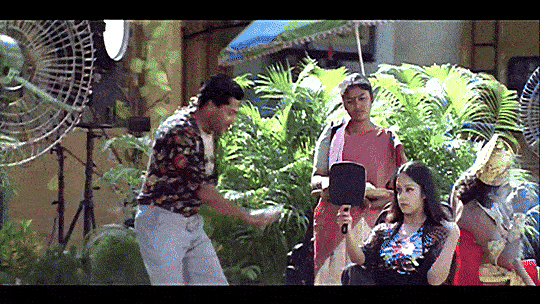

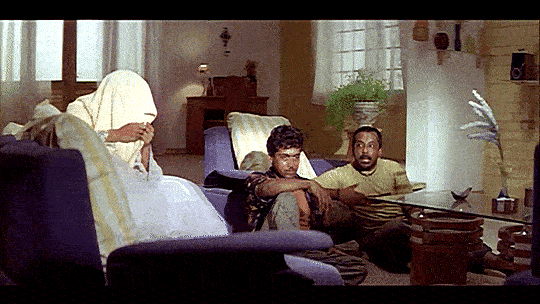
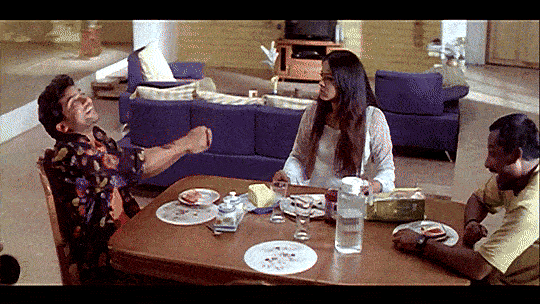


''oh, are you chandramukhi?! i kidnapped you in anger, now i'm sad chandramukhi might be postponed because of this! :(''
maayavi (2005)
#maayavi#suriya#jyothika#sujo#tamil cinema#kollywood#look i rewatched this recently and i gotta share about the forgotten sujo masterpiece#it was so fun i laughed so much aaah i missed this#mine*
9 notes
·
View notes
Text
Sarajevo Days Of Architecture
Weltraum, a radio podcast about space on the jabbering Independent Coastal Radio NOR hosted Dunja Krvavac from Days of Architecture in Sarajevo. I had this great opportunity to talk about the city, her travels and thoughts in Mostar, where we met in May.

Dunja Krvavac | Photo © Ajla Salkić
How can a young female architect work in Sarajevo?
DK: It has its ups and downs, like everywhere in the world, you have different challenges. Maybe Sarajevo is a bit more specific in terms that is a still a very traditional and patriarchal community. World of architecture here is full of men, so many men. Going through this field of old white men sometimes can be a little bit challenging. I think that we all have to do small steps, we all have to be focused on what we want to do and how we want to achieve it. Working in Sarajevo, as I said, I love being here, I was born here, I was raised here, I've been living here for thirty years and have no desire to live anywhere else. I think this is a beautiful canvas that still has to be painted with a lot of things. Me staying here is a decision I made.

Kazani Memorial in Sarajevo (project drawings). | Photo © Dunja Krvavac
Most of the contribution that I can make into this world, I think is specifically connected to Sarajevo. Trying to be an architect here - I mean it's a cliché to say it like this that I am a girl and this is a job full of men but it happens a lot even today that you’re walking through a construction site where you have a bunch of men not taking you seriously because you are a girl. I don't want to be negative, I am very privileged as I have a wonderful job, opportunities and community of people who support me but we still have to unite in order to make this city better after all it has been through in the 1990s.
The Balkans wars from the 1990s are almost forgotten in Europe - there was a dispute in Germany that the war in Ukraine is the first war after the II WW - how did different capital intervene and defined Bosnia and Herzegovina after 1990s?
DK: n Europe people might have forgotten about the Balkan war in the 1990s but here it’s still very much present. I was born in the first year of the war, in 1992 and maybe it's a fortune that I don't remember the war. Unfortunately, due to the way that the county functions and works, we are reminded of it every day. I [as most of my generation] have this inherited trauma. This situation of us [Bosnia and Herzegovina] being in transition and the huge amount of capital flow in the late 1990s and beginning of 2000s and even now, changed the city and its architecture completely. It became a capital-focused architecture. We used to have a wonderful developing city before the war where people were eager to build the city by building schools, museum, galleries, community, culture and today everything is focused on capital and investments. There is a small amount of planning done, people just grab opportunities to earn a lot of cash when they can.
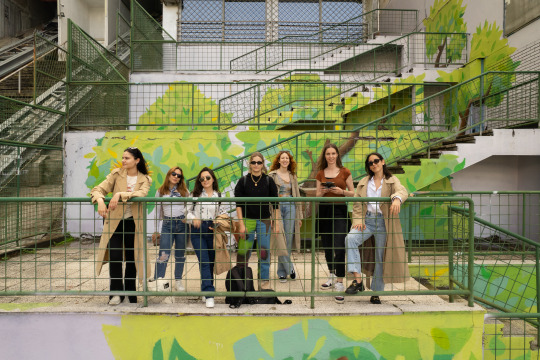
Workshop UNCONTEXT Dissecting the layers. | Photo © Sabina Hodović
Unfortunately, that's the general atmosphere now. It changed so much from socialist system transitioning to capitalism, I think we as a society still struggle to understand what is a position of an architect in this situation and context. There are a lot of people trying to be respectable towards the city and its architecture but in the end, 90% of all these efforts fail in terms that investments and politics - it's all that it matters to some people. It sounds a bit gloomy when I say all this, it sounds like there is not hope but I am an incurable optimist that things can be better. You need to make small steps and giving up is no option.
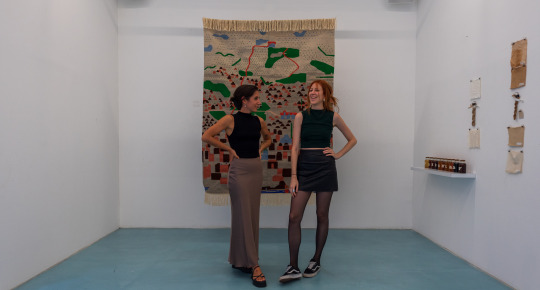
Exhibition UNCONTEXT Dissecting the layers | Photo © Sabina Hodović
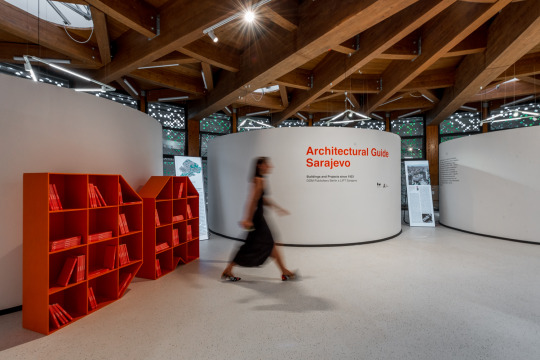
Architectural Guide Sarajevo. | Photo © Timur Babić
What did the specific capital coming from Middle East to the modernist city?
DK: This influx of Middle-Eastern capital is a very difficult topic to talk about. There is a lot foreigners coming here and they want to build, invest and sometimes to even live here. That's not an issue for me if people want to invest, I don't mind that. But what I do mind is the attitude that Bosnia and Herzegovina has taken when it comes to this or any type of investors; we have this small county attitude that we just let foreign investors do whatever they want. We are so scared that everything will fall apart if we don' let them to do everything they want.
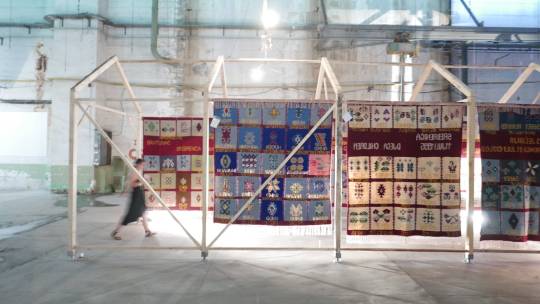
House of Memories for Memorial Center Srebrenica. | Photo © Ismet Lisica
Now we have these situations where investors are destroying most of our Olympic mountains with help of the locals. They are building huge settlements and gated neighborhoods on our mountains and the worst thing about this is that they don't really care about our traditions, customs, local experience. And we are doing nothing about it.
You are in the position of being able to travel a lot; how that influence on your work?
DK: It's a huge benefit for me that my work is connected to traveling. I discussed this with my best friend and partner in crime Irhana Šehović that we need to make our work travelabe, to meet new people in order to bring new perspectives into Sarajevo. When you are in the city for too long sometimes I have this tendency to oversee thing. You are constantly bombarded with local information that you don't filter it in a correct way. Traveling enables to connect with amazing people with new perspectives. Through LINA and other projects that we are involved in, we are making Bosnia visible again. We were visible before, we used to be an amazing county and then that horrible episode of the 1990s happened and we went some steps back. I think that everything that that we try to do here is a step forward to become better. There is no option of giving up.
What does a responsible building mean?
DK: It's a difficult question from many aspects, there is an architectural answer to that and there is a human answer to that as well. Architects are very self-centred, sometimes they [we] make buildings that are more about the architecture and the architect and less made for the community that is going to use this building.

Manifesto gallery of contemporary arts (project renderings). | Photo © Dunja Krvavac and Nikola Ostojić
I think that responsible architecture and responsible building is something where you put aside what the architecture and the architects is. That is almost not important, I always see architects as mediators. I can see space in a different way than someone else can and I can easily try to organize it. But there is an entire community that needs to use this space. It would be very narcissistic of me as an architect to say that this is an amazing building that I made and completely disregard that this building is going to be a crucial part of someone's life. If I design something it always has to be focused on the person using it. Me as an architect – I am irrelevant and not important. The only thing that is important are the people that are going to use the architecture. If you don't build for the community, if you don't interact with the community and if you don't put the community first as a part of your design process then it makes no sense.
Tell me more about the Days of Architecture and other projects that you are involved in?
DK: Days of Architecture are one of the most important projects that I am working on for almost nine years now. It's an important part of the city and regenerating the city after the war and transition.

Days of architecture 2023. | Photo © Harun Čerkez
We celebrated fifteen years of Days of architecture this year. It comes down as a festival but is so much more. During the festival we gather local and international experts to discuss important topics. It a place where we can research and introduce new perspectives into our local communities as the festival is very much connected to Sarajevo. During my presentations and lectures I say “Sarajevo is our playground” to research and experiment what might Sarajevo become in the future. I am proud that we have managed to stay relevant in the city for fifteen years. We are not supported from the state so we are trying to make steps forward with the festival with the best of our capabilities. I enjoy being involved into different activist projects like the Open Air Cinema Prvi Maj in the city on which I’m working right now with an amazing interdisciplinary team.

Open Air Cinema Prvi Maj (project drawings). | Photo © Dunja Krvavac
You are good within communicating with different generations right, for example the Doršner couple which built the Olympic City of Sarajevo?
DK: It is the most precious thing in the world to bring back these people and listen to them and take in all what they have to say. I am a child of two architects and I've met a lot of architects from elderly generations at our home. People sometimes tend to put them aside and not listen to what they have to say. Especially the Doršner couple, they are like an encyclopedia of knowledge with infinity of information coming from them. Due to our [country’s] poor archiving capabilities you cannot find this knowledge in books or online. You simply have to talk to them and reach out to get all information before it’s lost.
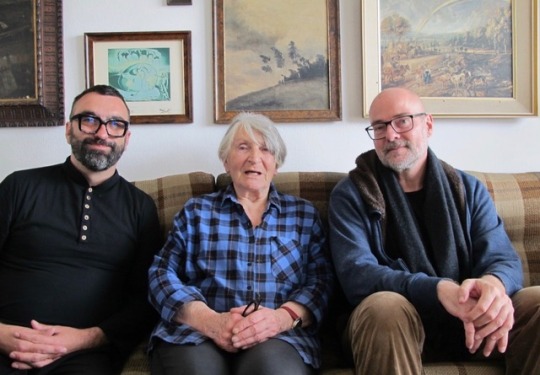
Boštjan Bugarič, Dragica Doršner and Martin Reichert during the interview in Sarajevo. | Photo © Zoran Doršner
The Doršner couple are responsible for the fact that Sarajevo had Olympic games and that we have all this amazing architectural Olympic heritage and legacy. I met them for the first time in 2021 during production of a movie which was showcased at the Venice Architecture Biennial as part of Italian pavilion.
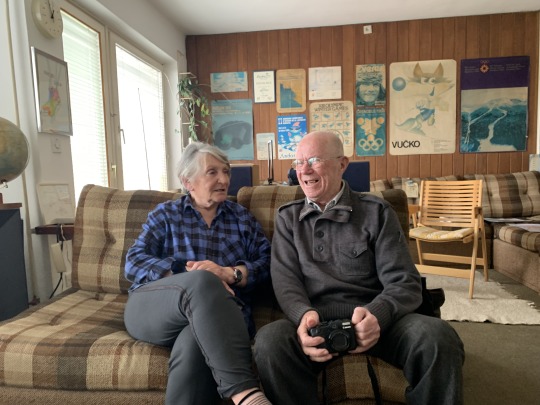
Dragica and Zoran Doršner in their home in Sarajevo. | Photo © Boštjan Bugarič
The three hour talk with the Doršner couple was some of the most amazing times of my life. This type to knowledge is very important for our generation to learn. Sharing information through different generations it is the most important way of keeping the knowledge alive.
What will architecture in the future look like?
DK: I ask myself this question all the time. There are so many things happening right now, from war in Ukraine to this horrible apartheid that is happening in Israel and Palestine. These situations make you wander what is the future of architecture, what is the future of the world? We have to change the way we think, we have to unlearn some things and question everything that we know. We need to be honest and very transparent. Architecture is the slowest changing profession in the world and we are still doing things very traditionally. Are we changing anything if we are working in box frames that we are working in? Having architecture for the sake of building - that's not the future. Focusing on communities, programs, systems - that we can change - is the most important thing at the moment. We seriously need to take stronger stands on many issues that are happening.
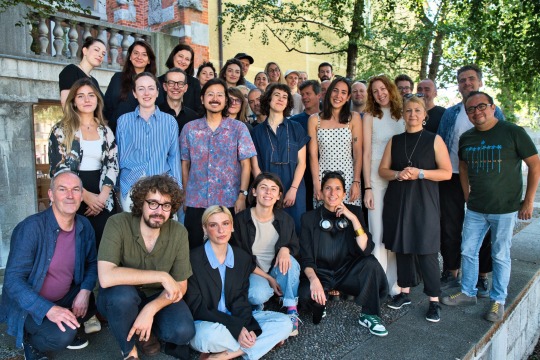
LINA Team Members. | Photo © Urban Cerjak
Dunja Krvavac enrolled at the Faculty of Architecture at University of Sarajevo in 2011 and finished her Bachelor’s degree in 2017, focusing on architectural design and constructive systems. In 2017, she started her Masters at the same faculty where she’s currently finishing her master thesis on urban planning and inclusive urbanism and design based on migrations. In 2018, as an Erasmus+ student, she spent one semester at the Norwegian University of Science and Technology in Trondheim, Norway, focusing her studies on urban planning and design. While studying, she’s been part of LIFT - spatial initiatives, a non-profit non-governmental organisation that aims to educate local communities on architecture, urbanism and design. She started as a volunteer in 2016 and moved on to become design team leader in 2019 and project coordinator of LIFT’s biggest project which is biennial festival Days of architecture Sarajevo and its complementary project Nights of architecture in 2020. As of soon, her interests expanded to fields of graphic and product design, resulting in awarded furniture designs, featured festival visuals and book illustrations. From 2020 she’s been actively freelancing and from 2022 she started working at a local architecture studio i.d.e.a Sarajevo. In 2021 she started working with Nikola Ostojić on various projects. She worked on Urban Lab Sarajevo, a collaborative project with UNDP BiH, Municipality Centar and Faculty of Sarajevo that focused on producing a digital platform for inclusive consultations several locations in Sarajevo. She continued exploring the topic of Sarajevo public spaces through joint Days of architecture and LINA European architecture platform project (UN)CONTEXT_Dissecting the layers: Sarajevo residency workshop.
Here You can listen to the WELTRAUM interview
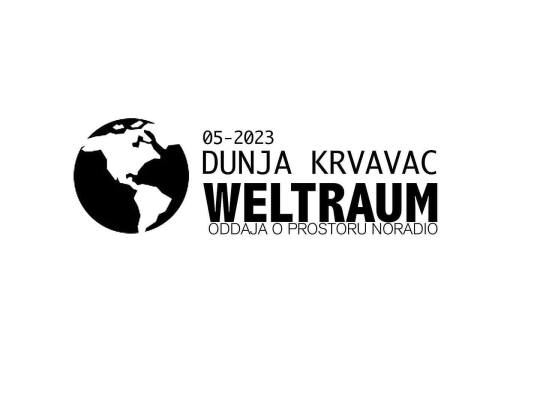
3 notes
·
View notes
Note
OMG RYU ❕❕you liking my rb of your zhongli fic just reminded me how much of a creep i sounded in the tags HELPPPP i swear i’m not a creep its me yue 😭😭😭 i was gonna read it once i’m back to chrollogy but i couldn’t wait and caved >< BUT YEAHHH anyway just letting u know how much i enjoyed that piece <3 hope ur saturday was gooooood :3


OMG NO SHHHH DONT BE SILLY /lh 💖
i had a feeling it was you before you even reblogged it the second time with all the tags bc which other moon princess is going to love chrollo as much as you hmmmmm?
and no one ever spoils me with commentary quite like you so i didn’t think you were a creep, i knew it was undoubtedly miss yue once i read your sweet words and that joke about why he’s the lord of rock dgajjsfahahahakaja
there’s one thing that’s hard about him and it ain’t his geo :^)
#I WAS WORRIED ABOUT LIKING THE RB I DIDNT KNOW IF YOU WANTED TO BE PERCEIVED#but tysm 🥺 i can’t even fit the commentary in one screenshot jfbjfnigmigkugku#i keep forgetting today is saturday. this whole day i’ve been calling today ‘monday’#i hope you’re having a good weekend and i will patiently waiting for your turn to share your masterpieces#i haven’t forgotten about your recent chrollo piece either >:)#<33333333333#ryu’s got mail!💌#sender: definitely not yue ♡
3 notes
·
View notes
Text
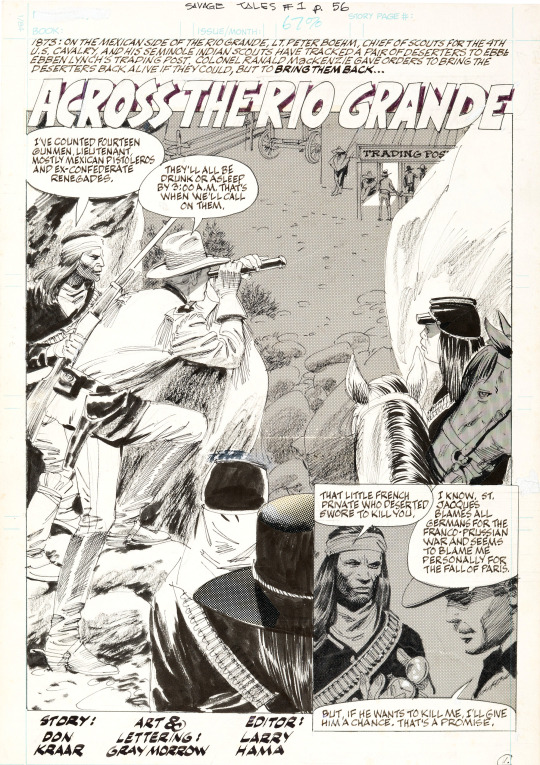


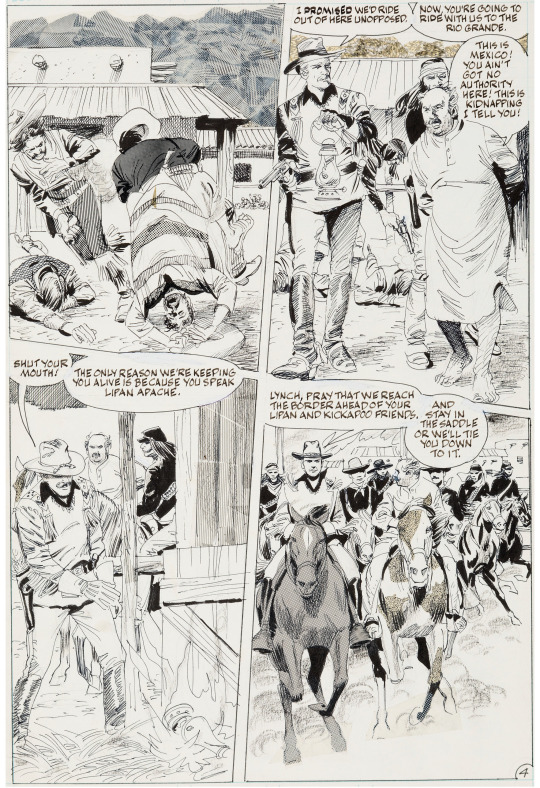
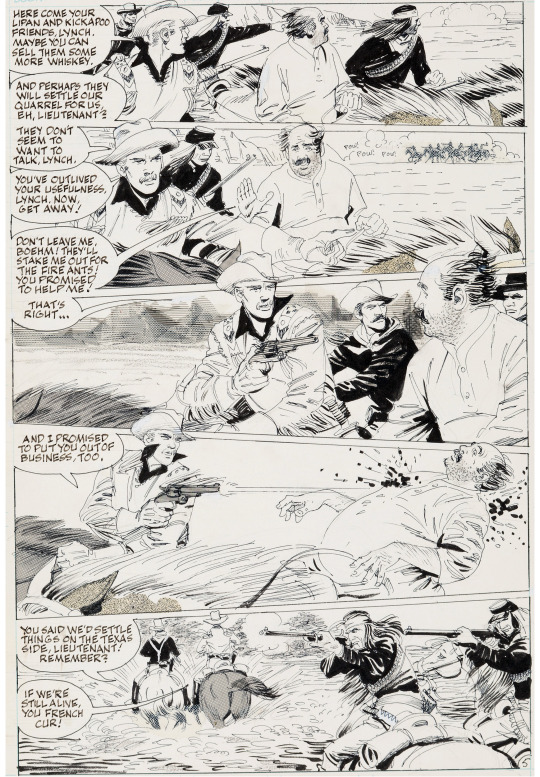

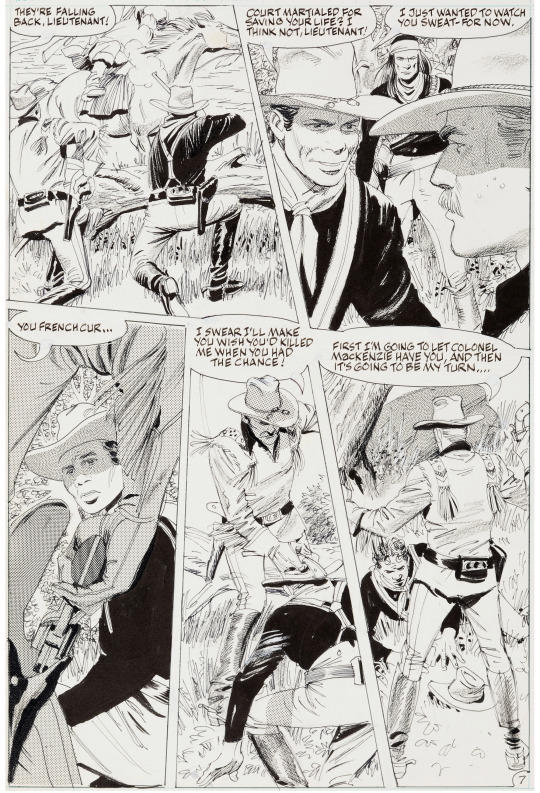

Forgotten masterpiece: Complete original art for “Across the Rio Grande” by Gray Morrow (art) and Don Kraar (story) from Savage Tales #1, published by Marvel Comics, October 1985.
#Gray Morrow#Don Kraar#forgotten masterpiece#original art#Savage Tales#marvel comics#western comics#Across the Rio Grande#been a while since i did one of these
48 notes
·
View notes
Text
I kinda wish (no pun intended) that people would stop getting on disney's case for being "safe"
I don't care if a movie is "safe". My bed is safe. Drawing is "safe" because it's something I know I'm good at. Singing alone in the shower but not wanting to be a performer is "safe". There's nothing intrinsically wrong with "safe" as long as you're trying to genuinely make something good.
Society has gotten so obsessed with the idea that everything has to be groundbreaking that we forget humans and technology both have limits, that every story has been told before in other ways and other patterns, and that excellence and groundbreaking-ness only exist when surrounded by "average" content. I'd prefer that average be "watchably good" over "completely awful".
I don't care if something is considered "average" or "safe" because society has the attention span of a squirrel now and needs something new every other second to get any serotonin out of something. I'll take a little formulaic, a little predictable, if characters or a world or a story have enough care and new-ness in them, by virtue of the fact that every story is just clichés arranged in new orders. I don't think a story should have to be groundbreaking to be good.
Also, Spider-Man: ITSV was dripping with cliché, what made it "groundbreaking" was the artistry and presentation. Take any excellent movie off its pedestal and you have a flawed work of art made by flawed people who run flawed companies. Stop holding art and corporations to standards the individuals they're made of can't meet.
#Obviously you shouldn't excuse laziness or corruption#But I feel like a lot of genuinely good things get dismissed as lazy now#When a decade or two ago it just would have been a Good Movie or Good Story.#If Rise of the Guardians had been released today it would have been dismissed as “lazy”#How to Train Your Dragon#Tons of beloved childhood stories would be forgotten now#And now we're so hypercritical of everyone and everything and every teeny flaw#We aren't even letting the next generation make good memories with the movies they're getting#Shooting down every new piece of media that isn't a “subversive masterpiece”#I just want to be able to go to the theaters without being politically and morally wrong for doing so-
7 notes
·
View notes
Text
Why is " Ride the Cyclone " so good and why am i finding out about it's existence just NOW???!

No seriously i've been singing " The ballad of Jane Doe " and " Talia " all day at work and i don't regret it
#ride the cyclone#no seriously#it's a lil masterpiece#new music obsession unlocked#jane doe has somehow pesca vibes#perhaps her fear of being forgotten#but anyway#time to listen to the whole musical AGAIN
6 notes
·
View notes
Note
Hi hi I keep forgetting to send this to you but I drew your Vio with his flowe crown

Sorry if it's bad I whipped it up during German class :3
OH MY GOSH??? HES SO SWEET LOOKING THANK YOU :00 ?!!!
#asks#forgotten fourth au#ffau#yall keep sending me masterpieces#best birthday gift ever actually#this is amazing#it looks so so so good!#ffau asks
19 notes
·
View notes